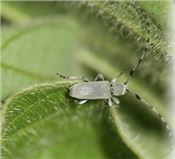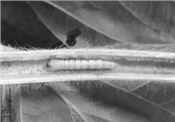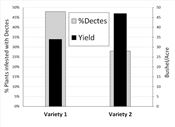Soybean Stem Borer Infestations Are Being Noticed By Kentucky Growers: Yield Might Be Reduced
DR. RAUL T. VILLANUEVA
PRINCETON, KY.
In 2017, there were several reports of Dectes presence in commercial fields in Webster, Henderson, and McLean counties in Kentucky. Soybean plants infested with Dectes larva or tunneling caused by this insect ranged from 25 percent to 55 percent (Villanueva et al. 2017). In 2018, I have received reports of fields infested with this pest from Christian, McLean, and Hickman counties, and from southern Illinois and southern Indiana. The soybean stem borer might have been expanding its geographical range in Kentucky or soybean farmers might have been noticing its presence. In Hickman County. a soybean grower noticed that yields of one cultivar was 13 bushels/Acre higher than a second cultivar that produced an average of 34 bushels/Acre. Both soybean cultivars were planted besides each other and from the farmer’s house on top of a hill he was able to observe some differences in both cultivars. After visiting this site, I found that, from a random subsample of 25 plants from each cultivar, 28 percent and 48 percent of the plants were infested with Dectes (Figure 4). These percentages correspond to the cultivars with high and low yields, respectively.
Most of the scientific evidence about yield decrease by Dectes did not find direct yield reductions, other than lodging of plants under drought conditions, winds, and when soil moisture is lower than 70 percent. In this specific case (Hickman County), yield reduction is a firsthand account, and can have some significance as one of these two varieties might be tolerant to damages caused by Dectes, and the percentages found on the presence of this pest correspond to the yields observed by the farmer.
Another aspect of interest in this report is that in Hickman County, the presence of natural enemies (parasitoid larva feeding on Dectes) was not observed, whereas parasitism in McLean County and at the Research and Education Center in Princeton KY, were high (reach to 80 percent in some cases). This parasitoid wasp is in process of identification. ∆
DR. RAUL VILLANUEVA: Extension Entomologist, University of Kentucky

Figure 1. Adult Dectes stem borer with a distinctive long antennae that
can be 1.5 times longer than the length of its body.
Photo: Nathan Yielding, UK

Figure 2. Dectes larva has deep segments with the appearance of an accordion,
and can be creamy white with an orange-red head coloration.
Photo: Raul T. Villanueva, UK

Figure 4. Percentages of plants with live larva or tunnels caused by Dectes stem borer from
a random subsample of 25 plants per cultivar from a commercial field in Hickman County, KY.